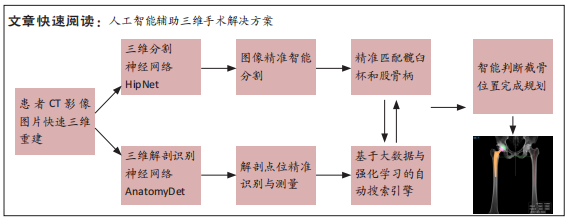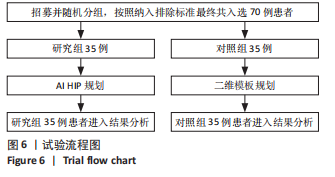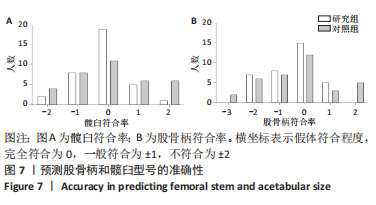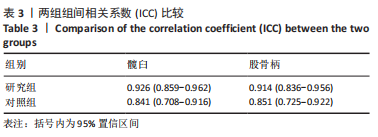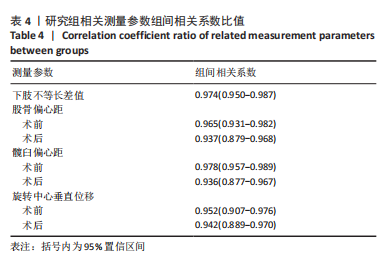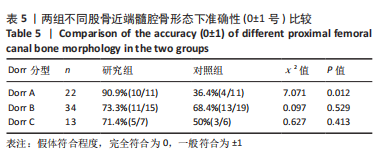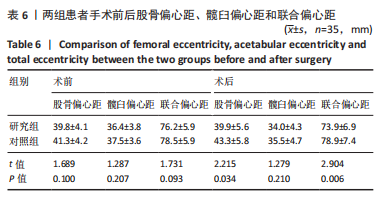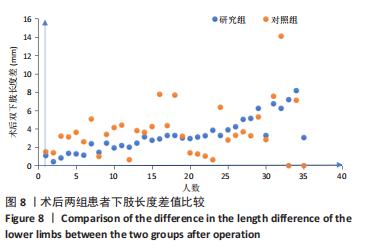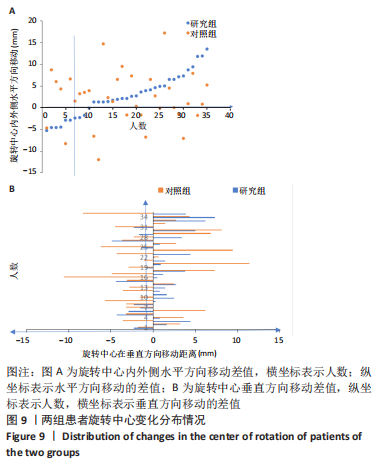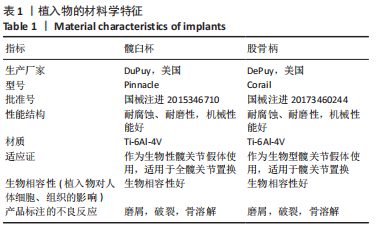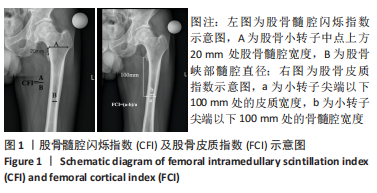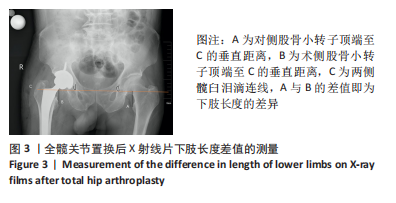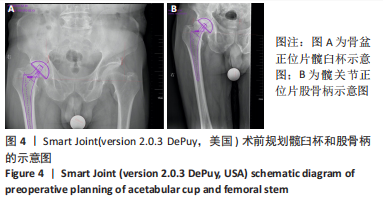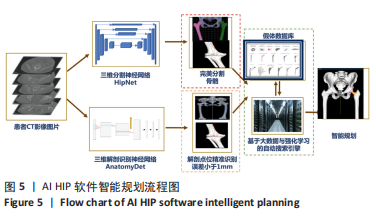[1] INOUE D, KABATA T, MAEDA T, et al. Value of computed tomography-based three-dimensional surgical preoperative planning software in total hip arthroplasty with developmental dysplasia of the hip. J Orthop Sci. 2015;20(2):340-346.
[2] MAINARD D, BARBIER O, KNAFO Y, et al. Accuracy and reproducibility of preoperative three-dimensional planning for total hip arthroplasty using biplanar low-dose radiographs : A pilot study. Orthop Traumatol Surg Res. 2017;103(4):531-536.
[3] MALONEY WJ, KEENEY JA. Leg length discrepancy after total hip arthroplasty. J Arthroplasty. 2004;19(4 Suppl 1):108-110.
[4] SEAGRAVE KG, TROELSEN A, MALCHAU H, et al. Acetabular cup position and risk of dislocation in primary total hip arthroplasty. Acta Orthop. 2017;88(1):10-17.
[5] LINDBERG-LARSEN M, JØRGENSEN CC, SOLGAARD S, et al. Increased risk of intraoperative and early postoperative periprosthetic femoral fracture with uncemented stems. Acta Orthop. 2017;88(4):390-394.
[6] PETRETTA R, STRELZOW J, OHLY NE, et al. Acetate templating on digital images is more accurate than computer-based templating for total hip arthroplasty. Clin Orthop Relat Res. 2015;473(12):3752-3759.
[7] HOLZER LA, SCHOLLER G, WAGNER S, et al. The accuracy of digital templating in uncemented total hip arthroplasty. Arch Orthop Trauma Surg. 2019;139(2):263-268.
[8] DAMMERER D, KEILER A, HERRNEGGER S, et al. Accuracy of digital templating of uncemented total hip arthroplasty at a certified arthroplasty center: a retrospective comparative study. Arch Orthop Trauma Surg. 2021 Mar 16. doi: 10.1007/s00402-021-03836-w. Online ahead of print.
[9] SARIALI E, MAUPRIVEZ R, KHIAMI F, et al. Accuracy of the preoperative planning for cementless total hip arthroplasty. A randomised comparison between three-dimensional computerised planning and conventional templating. Orthop Traumatol Surg Res. 2012;98(2):151-158.
[10] WAKO Y, NAKAMURA J, MIURA M, et al. Interobserver and Intraobserver Reliability of Three-Dimensional Preoperative Planning Software in Total Hip Arthroplasty. J Arthroplasty. 2018;33(2):601-607.
[11] KNAFO Y, HOUFANI F, ZAHARIA B, et al. Value of 3D Preoperative Planning for Primary Total Hip Arthroplasty Based on Biplanar Weightbearing Radiographs. Biomed Res Int. 2019;2019:1932191.
[12] BANERJEE S, CHERIAN JJ, ELMALLAH RK, et al. Robot-assisted total hip arthroplasty. Expert Rev Med Devices. 2016;13(1):47-56.
[13] BORJALI A, CHEN AF, BEDAIR HS, et al. Comparing the performance of a deep convolutional neural network with orthopedic surgeons on the identification of total hip prosthesis design from plain radiographs. Med Phys. 2021;48(5):2327-2336.
[14] HAEBERLE HS, HELM JM, NAVARRO SM, et al. Artificial Intelligence and Machine Learning in Lower Extremity Arthroplasty: A Review. J Arthroplasty. 2019;34(10):2201-2203.
[15] 吴东,柴伟,刘星宇,等.人工智能全髋关节置换术髋臼杯放置算法的实验研究[J].中华骨科杂志,2021,41(3):176-185.
[16] DING X, ZHANG B, LI W, et al. Value of preoperative three-dimensional planning software (AI-HIP) in primary total hip arthroplasty: a retrospective study. J Int Med Res. 2021;49(11):3000605211058874.
[17] HUO J, HUANG G, HAN D, et al. Value of 3D preoperative planning for primary total hip arthroplasty based on artificial intelligence technology. J Orthop Surg Res. 2021;16(1):156.
[18] ALNAHHAL A, ASLAM-PERVEZ N, SHEIKH HQ. Templating Hip Arthroplasty. Open Access Maced J Med Sci. 2019;7(4):672-685.
[19] DORR LD, FAUGERE MC, MACKEL AM, et al. Structural and cellular assessment of bone quality of proximal femur. Bone. 1993;14(3): 231-242.
[20] HARRIS WH. Traumatic arthritis of the hip after dislocation and acetabular fractures: treatment by mold arthroplasty. An end‐result study using a new method of result evaluation. J Bone Joint Surg Am. 1969;51(4):737-755.
[21] 孙伟,李子荣.2019国际骨循环研究协会股骨头坏死分期[J].中华骨科杂志,2020,40(13):889-892.
[22] SARIALI E, BOUKHELIFA N, CATONNE Y, et al. Comparison of Three-Dimensional Planning-Assisted and Conventional Acetabular Cup Positioning in Total Hip Arthroplasty: A Randomized Controlled Trial. J Bone Joint Surg Am. 2016;98(2):108-116.
[23] ISSA K, PIVEC R, BOYD B, et al. Comparing the accuracy of radiographic preoperative digital templating for a second- versus a first-generation THA stem. Orthopedics. 2012;35(12):1028-1034.
[24] OGAWA T, TAKAO M, SAKAI T, et al. Factors related to disagreement in implant size between preoperative CT-based planning and the actual implants used intraoperatively for total hip arthroplasty. Int J Comput Assist Radiol Surg. 2018;13(4):551-562.
[25] LITTLE NJ, BUSCH CA, GALLAGHER JA, et al. Acetabular polyethylene wear and acetabular inclination and femoral offset. Clin Orthop Relat Res. 2009;467(11):2895-2900.
[26] CECH A, KASE M, KOBAYASHI H, et al. Pre-operative planning in THA. Part III: do implant size prediction and offset restoration influence functional outcomes after THA? Arch Orthop Trauma Surg. 2020; 140(4):563-573.
[27] MAHMOOD SS, MUKKA SS, CRNALIC S, et al. Association between changes in global femoral offset after total hip arthroplasty and function, quality of life, and abductor muscle strength. A prospective cohort study of 222 patients. Acta Orthop. 2016;87(1):36-41.
[28] XU J, PIERREPONT J, MADURAWE C, et al. The effect of varus stem placement on joint offset during total hip arthroplasty: a virtual study. Hip Int. 2022;32(5):620-626.
[29] HELLER MO, SCHRÖDER JH, MATZIOLIS G, et al. Musculoskeletal load analysis. A biomechanical explanation for clinical results--and more. Orthopade. 2007;36(3):188,190-194.
[30] SCHEERLINCK T, DE WINTER E, SAS A, et al. Hip implants can restore anatomical and medialized rotation centres in most cases : a 3D templating study comparing four implantation strategies. Bone Jt Open. 2021;2(7):476-485.
[31] SHEN J, SUN J, MA H, et al. High Hip Center Technique in Total Hip Arthroplasty for Crowe Type II-III Developmental Dysplasia: Results of Midterm Follow-up. Orthop Surg. 2020;12(4):1245-1252.
[32] MEERMANS G, DOORN JV, KATS JJ. Restoration of the centre of rotation in primary total hip arthroplasty: the influence of acetabular floor depth and reaming technique. Bone Joint J. 2016;98-B(12):1597-1603.
[33] DASTANE M, DORR LD, TARWALA R, et al. Hip offset in total hip arthroplasty: quantitative measurement with navigation. Clin Orthop Relat Res. 2011;469(2):429-436.
[34] NOSSA JM, MUÑOZ JM, RIVEROS EA, et al. Leg length discrepancy after total hip arthroplasty: comparison of 3 intraoperative measurement methods. Hip Int. 2018;28(3):254-258. |
